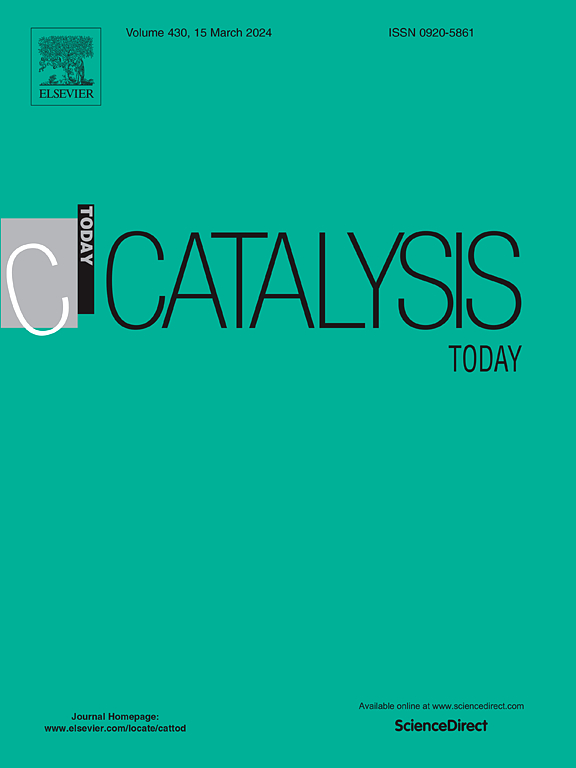Zr-modified USY zeolite as an efficient catalyst for the production of bio-jet fuel precursors from levulinic acid and furfural in the absence of solvent
IF 5.2
2区 化学
Q1 CHEMISTRY, APPLIED
引用次数: 0
Abstract
The high potential of using levulinic acid and furfural as platform molecules for the production of oxygenated adducts suitable as precursors for SAF synthesis is studied through the aldol condensation of both molecules. The research is the first-time demonstration of solventless acid-catalysed levulinic acid/furfural aldol condensation. The catalytic performance of a commercial H-USY zeolite and two post-synthetic variations thereof, with different dealumination degree and Zr loading, is analyzed, aiming at tuning the acid catalytic properties. The catalyst with an almost complete Al removal accompanied by the highest Zr wt% (Zr-USY-2) gave the best results in terms of selective conversion of furfural, pointing out to the Lewis acid sites as the main active sites to promote the aldol condensation reaction. An experimental design allowed to identify the optimal LA/FAL molar ratio (9/1) and reaction temperature (140 °C), while catalyst loading presented a minor significance. The optimization of the reaction parameters allowed to achieve a maximum furfural conversion of 88 %, combined with a yield towards the desired C10 adducts of 55 %. Furthermore, despite the catalytic performance of this material is slightly impaired in consecutive reaction cycles, it can be recovered with a thermal regeneration step, indicating a good reusability.
zr修饰的USY沸石在无溶剂条件下,作为乙酰丙酸和糠醛生产生物喷气燃料前驱体的有效催化剂
以乙酰丙酸和糠醛为平台分子,通过醛醇缩合反应,研究了两种分子制备适合作为SAF前体的氧化加合物的高潜力。该研究首次证实了无溶剂酸催化乙酰丙酸/糠醛缩合反应。分析了一种H-USY分子筛的催化性能及其合成后的两种不同脱铝程度和Zr负载的分子筛,旨在调整其酸催化性能。几乎完全去除Al且Zr wt% (Zr- usy -2)最高的催化剂对糠醛的选择性转化效果最好,表明Lewis酸位点是促进醛缩反应的主要活性位点。实验设计可以确定最佳的LA/FAL摩尔比(9/1)和反应温度(140°C),而催化剂负载的影响较小。反应参数的优化使糠醛转化率达到88 %,C10加合物的产率达到55 %。此外,尽管该材料的催化性能在连续的反应循环中略有下降,但它可以通过热再生步骤恢复,表明了良好的可重复使用性。
本文章由计算机程序翻译,如有差异,请以英文原文为准。
求助全文
约1分钟内获得全文
求助全文
来源期刊

Catalysis Today
化学-工程:化工
CiteScore
11.50
自引率
3.80%
发文量
573
审稿时长
2.9 months
期刊介绍:
Catalysis Today focuses on the rapid publication of original invited papers devoted to currently important topics in catalysis and related subjects. The journal only publishes special issues (Proposing a Catalysis Today Special Issue), each of which is supervised by Guest Editors who recruit individual papers and oversee the peer review process. Catalysis Today offers researchers in the field of catalysis in-depth overviews of topical issues.
Both fundamental and applied aspects of catalysis are covered. Subjects such as catalysis of immobilized organometallic and biocatalytic systems are welcome. Subjects related to catalysis such as experimental techniques, adsorption, process technology, synthesis, in situ characterization, computational, theoretical modeling, imaging and others are included if there is a clear relationship to catalysis.
 求助内容:
求助内容: 应助结果提醒方式:
应助结果提醒方式:


